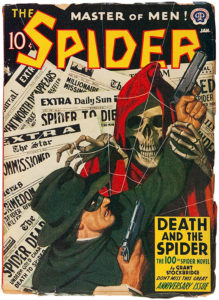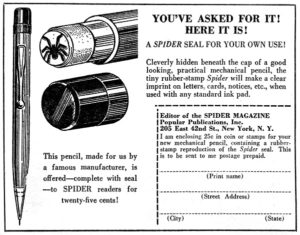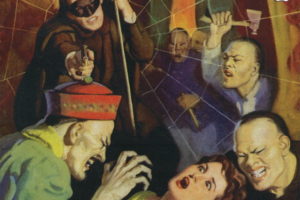
“Death and The Spider” was originally published in the January 1942 issue of The Spider magazine. Richard Wentworth’s mentor, the mystic Mar-lar-delan had prophesied, “When your people need you most… When Death walks the earth like a man… in that hour, my son — you will die!” Had the black hour come? A man called Death threatens the nation as The Spider undertakes what may be his last foray!
This was the 100th Spider story, and author Norvell Page pulled out all the stops to give readers a story that touches on the back history of The Spider. It’s a story that involves the mysticism of the East. And it’s a corker. An evil cult of psychic men pour out their devilish forces and turn people into criminals. Wentworth’s greatest battle is upon him. The fate of the world lies in his hands. Wentworth must decide: avoid battle and survive, or fight evil… perhaps win… but die. Yes, a very good Spider story that’s a lot of fun to read.
Strange things are happening in New York. Perfectly normal people commit horrible crimes, then later plead, “I don’t know why I did it!” Even the police aren’t immune to the strange rash of crime.
Death enters the picture
Three men had died, all three psychics. The assassin called himself by the name of Death. Nita van Sloan, sweetheart of our hero, remembers a prophecy given Wentworth by the aged abbot of Tibet, Mar-lar-delan. Wentworth had studied the mystic secrets of the East under him. He had said: “When evil has the world by the throat, when your people and your country need you most; when Death walks the earth like a man, in that hour, my son, you will die.” Yes, apparently this fellow who calls himself Death is behind it all. And the threat to Richard Wentworth is most real.
Just as a quick aside, this story takes a sympathetic view of psychics. In the majority of pulp tales, psychics, fortune tellers, mediums and the like are portrayed as crooked. Usually, our hero is out to expose them and release their victims from their evil grasp. But, in an interesting turnabout, all three murdered psychics are treated with respect. As far as Wentworth knows, all three have been honest and devout, actually trying to serve people. Interesting.
Police Commissioner Stanley Kirkpatrick arrives at the latest psychic’s home with The Spider in cuffs. He goes inside. But it’s not really Kirkpatrick or The Spider. It’s really Death and an associate in disguise. The real Kirkpatrick shows up 10 minutes later with Richard Wentworth. They enter the home to find the psychic and the officer guarding him dead, their throats cut.
Wentworth realizes that Death does not use a disguise in the normal sense, but rather some sort of hypnotic illusion… something learned in the mysterious East. It’s a kind of mass hypnotism that affects entire crowds, not just individuals. Mass hypnotism? Shades of The Shadow! Well… the radio version, anyway.
Wentworth’s old mentor, Mar-lar-delan, shows up in New York. Mar-lar-delan is a Tibetan lama. The first time Wentworth sees him, it’s a hypnotic illusion… a trap to kill him, which he escapes by the skin of his teeth. When he arrives home, he finds the real Mar-lar-delan waiting for him. Two Tibetans stand by a coffin-like box. Inside, Mar-lar-delan lies in a state of suspended animation. The old man awakes at Wentworth’s touch.
Mar-lar-delan takes him to a house, where The Spider finds two of Death’s minions, and he first meets Death himself. A dark figure, cowled, enormous, and beneath the hood, the bony face of death. There is a psychic battle between Mar-lar-delan and Death. One seems to whisper “die” and the other “live.” It is a powerful battle wills of masters of hypnosis, and The Spider stand by helpless, watching. Yup, pretty great stuff!
A newcomer arrives… one of Mar-lar-delan’s novice monks, a figure in a robe. Wentworth, in the company of the monk, is taken to a house where two kidnapped girls are supposedly prisoner. He enters. The Spider lures six men upstairs and the ensuing battle he defeats them all. The seal of The Spider is placed upon their foreheads, by means of a metal pencil. Say, what, now? A metal pencil?
Let’s promote our pencil premium

Now that’s interesting. Instead of placing the crimson seal of The Spider on the foreheads by means of his cigarette lighter, The Spider uses the base of a silver pencil. Apparently he’s lost his lighter, and has to make do with a cheaper substitute. The jaded among us might suspect it was done to help promote a premium that the magazine was offering for the paltry sum of 25 cents.
It was a mechanical pencil with a Spider symbol on the eraser end. To be used as a rubber stamp, if the lucky kid who owned one had a stamp pad with red ink in it. The offer was valid from July 1941 until March 1942. And in the pulp stories, the pencil was The Spider’s featured method of applying his seal for less than a year, before he returned to using his cigarette lighter. A coincidence? But I digress. Moving on…
One of the kidnapped girls gives The Spider a clue to the location of the hidden monastery where the monks practice their black mass. And so the battle rages on. Wentworth has battles both physical and psychic with Death and his evil horde. And in the end, cities across the nation are affected by the hypnotic compulsion to kill. Hundreds of cases of industrial sabotage. Mutinies in Army Camps. A great fire sweeps a small city off the map. The entire nation is near utter chaos. He even has to rescue the President of the United States from the dominion of Death. Whew! Now that’s some story!
A common thread in Spider pulp stories is paranoia. It rises again in this one. The Spider can’t be sure who to trust. Anyone could be Death using his powers of mass hypnosis to disguise himself. His old friend Mar-lar-delan can’t be trusted. Even Nita van Sloan could be suspected!
We don’t get to see a lot of the familiar old recurring characters in this tale. Most are put out of action. Nita lies unconscious for most of the story. Ram Singh is similarly out of action, severely wounded and in the hospital. Jackson doesn’t get to do much, nor does old faithful Jenkyns. That may be typical of many Spider stories, but usually Police Commissioner Kirkpatrick gets a larger part, as he tried to expose Wentworth as The Spider. Here, his role is reduced. The focus is more on Richard Wentworth and the mystic Mar-lar-delan.
The Richard Wentworth backstory
One of the things I really found interesting about this story were the references to Wentworth’s history. His backstory is filled in a bit. We know he spent years in Tibet studying under Mar-lar-delan. Wentworth recognizes the powers of the East, powers which certainly approached the supernatural. He himself practices some of them, such as hypnotism, so we are told. Yes, Wentworth is a hypnotist. We see a demonstration when he convinces Kirkpatrick that a button is actually a valuable pearl. No wonder he is referred to as the “Master of Men.” And I assume he’s also known as the “Master of Buttons.”
This story repeats the old myth that a hypnotized person will come out of his trance when the hypnotist dies. You’ve seen it in the old black-and-white movies of the ’30s and ’40s. And you see it again, here. When the master hypnotist who calls himself Death is killed at the story’s end, all his victims automatically come out of their trances. Ah, fiction… ya gotta love it.
The story drops a lot of little tidbits of information, which might have been for the benefit of new readers not familiar with the series… readers who picked up the magazine because it was a well-touted 100th issue. Let’s give a quick rundown of them:
The Commissioner’s chauffeur is Garrity. Kirkpatrick has a wife, Lona — she and Nina attend the opera together in this story. Jackson’s wife is Marianne. These spouses are rarely mentioned, so the reader is reminded that they do exist.
For those of you not familiar with the history of Stanley Kirkpatrick’s love affair with Lona, it began in the July 1941 issue “Murder’s Black Prince,” when he fell madly in love with a female criminal. She reformed in the August 1941 story “The Spider and the Scarlet Surgeon,” and Kirkpatrick proposed in the October tale “Satan’s Seven Swordsmen.” They married the next month in November’s “Volunteer Corpse Brigade.”
Reference is made to the current world situation, as war raged across the globe. Mar-lar-delan says, “Good and evil are centered now, in this country. Forces of evil have grown powerful. You know at least one of the leaders.” Wentworth says, “If you mean Adolf…” Mar-lar-delan interrupts him. “Names do not matter. I know him by another and older name.” But we know. (Wink… wink…) Yes, evil has been around for a long time, it seems, and Mar-lar-delan knows its many faces.
We get a brief glimpse of The Spider’s hidden garage in this story. It’s somewhere near his home, and is where he goes to strip off his disguise of The Spider before going to his apartment. You don’t want to enter your own home in disguise, I suppose. I know I sure don’t.
Did you know that The Spider carries a powerful battery in his belt buckle? Yes, it’s a gadget he uses in this story to escape the police. He does this by pressing a metal clasp on his cape to his belt buckle. There is a faint bluish spark. Police trying to put manacles on him receive an electric shock. Of course, a nasty side effect is that his cape catches on fire. That doesn’t stop The Spider, of course. A burning cape is the least of his worries!
Faithful readers know that Commissioner Kirkpatrick has always suspected that The Spider is Wentworth, but time and time he has been proved wrong, yet in each new story he still carries those fresh suspicions. Is this man a dunce or something? Well, this story admits that Kirkpatrick ignores the many alibis that have been established by Wentworth, figuring that anyone as clever as The Spider could accomplish such alibis without too much difficulty.
The wrap-up
This story is a bit shorter than usual, just shy of 39,000 words. It makes me wonder if the story was edited. There is some evidence of editing, at least to my eyes. Some characters are introduced and then just ignored after that. Just what happened to Liza Edwards, for example? She was introduced at the beginning of the story and played a vital role up through the middle… then she’s dropped. Curious.
And at the story’s end, there is a terrific scene with an autogiro flown by Death, dropping bombs on The Spider. But the scene seems cut way too short. Just as things are getting nasty, a wind blows the aircraft away. I guess we are supposed to read between the lines and figure out that it was the mystic abilities of Mar-lar-delan that created that wind. But a couple of lines of exposition would have helped. C’mon!
Perhaps because of some editing, the story moves at the speed of an express train. It seems most of The Spider stories do, and this one is no exception. You barely get a chance to take a breath. I can recommend the story as a fun and thrilling ride with The Spider. For the 100th issue, Novell Page did a very nice job. Now, that’s pulp!


What a thrilling story, and enjoyable, amusing, and informative report!
Re that Spider Seal Pencil Premium…
Professional Alarmist: “Now kids are going to go around killing people, just so they can stamp them with their Seal of the Spider!”
If I was a kid back then, I sure would have wanted one of those Spider pencils. I would have begged and pleaded with my parents, even though 25¢ was a lot of money for a mailaway. “Can I get one, Mom, pleeeeaaasssee? I promise I won’t kill anyone!”
Of course chances were quite good that my sister would have awakened some morning with a red spider stamped on her forehead.
I’m told that the pulp publishers made up these pencils as the orders came in. In the case of most other premiums, a quantity of them was produced in advance. But for the Spider pencils, they were made as they were ordered. Kinda like today’s MOD (manufactured on demand) method of making DVDs and books and the like. Which partially explains why these Spider pencils are so rare today. There were no “left overs” to find in some warehouse.
(sigh…)